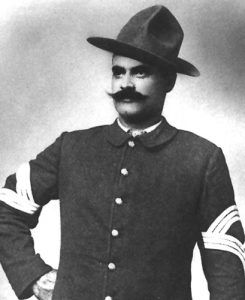Benjamin Brown (Medal of Honor) facts for kids
Quick facts for kids
Benjamin Brown
|
|
|---|---|

Benjamin Brown in his Army Uniform
|
|
| Born | 1859 Spotsylvania County, Virginia |
| Died | September 5 1910 (aged 50–51) Washington, D.C. |
| Place of burial |
United States Soldiers' and Airmen's Home National Cemetery Washington, D.C.
|
| Allegiance | United States of America |
| Service/ |
United States Army |
| Rank | Sergeant |
| Unit | 24th Infantry Regiment |
| Battles/wars | American Indian Wars |
| Awards | Medal of Honor |
Benjamin Brown (born 1859 – died September 5, 1910) was a brave Buffalo Soldier in the United States Army. He received the Medal of Honor, which is America's highest award for military bravery. He earned this honor for his actions during the Indian Wars in the western United States.
Contents
Who Was Benjamin Brown?
Benjamin Brown was born in Spotsylvania County, Virginia, in 1859. He joined the United States Army and became a Buffalo Soldier. Buffalo Soldiers were African American soldiers who served in the U.S. Army after the American Civil War.
Brown's Army Career
Brown served in the 24th Infantry Regiment. He was part of Companies C and H, and also played in the Army band. During his time in the military, he held several ranks. He started as a Private and later became a Corporal, Sergeant, and even a Drum Major.
He served in many different places across the American West. He also served in the Philippines.
The Wham Paymaster Ambush
On May 11, 1889, Sergeant Brown was serving in Arizona Territory. His unit was escorting Major Joseph W. Wham. Major Wham was transporting a large amount of money. It was over $28,000 in gold and silver coins. This money was the payroll for soldiers.
The Attack
Major Wham and his eleven Buffalo Soldier escorts were ambushed. The attackers had blocked the road with a large boulder. Sergeant Brown bravely led his men forward to move the boulder. Suddenly, the attackers opened fire from a slope above the road.
The soldiers quickly took cover. Brown and two other privates were separated from the main group. Brown was shot in his arm. Even though he was wounded, he fired his revolver at the attackers. When his revolver was empty, he took a rifle from one of the privates and kept fighting.
Continuing the Fight
One of the privates was wounded, and Brown was shot a second time. The three men then moved to a dry creek bed for more cover. The fighting lasted for about an hour and a half. Eight of the eleven soldiers were wounded during the attack. Brown was wounded again, this time in his other arm.
After the battle, the attackers took the payroll and left. Brown and another soldier were too badly hurt to move. They were cared for until a doctor could arrive.
Medal of Honor
For his incredible bravery during this ambush, Benjamin Brown received the Medal of Honor. This award was given to him on February 19, 1890. Another soldier, Corporal Isaiah Mays, also received the Medal of Honor for his actions that day. Eight other soldiers received a Certificate of Merit.
Later Life and Legacy
Benjamin Brown was an excellent marksman. In 1904, he was ranked as the fifty-fourth best rifleman in the entire U.S. Army. He had to retire from the Army in 1904. This was because he suffered a stroke and could no longer serve.
Brown spent the rest of his life at the Armed Forces Retirement Home in Washington, D.C.. He passed away in 1910. He was buried at the United States Soldiers' and Airmen's Home National Cemetery.

